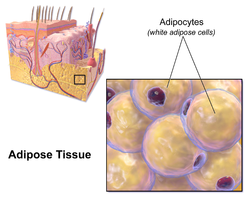White adipose tissue
| White adipose tissue | |
|---|---|
 Illustration depicting white fat cells. | |
| Details | |
| Identifiers | |
| Latin | textus adiposus albus |
| MeSH | D052436 |
| TH | H2.00.03.4.00002 |
| FMA | 20117 |
| Anatomical terminology | |
White adipose tissue or white fat is one of the two types of adipose tissue found in mammals. The other kind is brown adipose tissue. White adipose tissue is composed of monolocular adipocytes.
In humans, the healthy amount of white adipose tissue varies with age, but composes between 6-25% of body weight in adult men and 14-35% in adult women.[1][additional citation(s) needed]
Its cells contain a single large
White adipose tissue is used for energy storage. Upon release of insulin from the
White adipose tissue also acts as a thermal insulator, helping to maintain body temperature.
The hormone leptin is primarily manufactured in the adipocytes of white adipose tissue[7] which also produces another hormone, asprosin.
Location and morphology

White adipose tissue is most abundant in mammals and its distribution greatly varies among different species.
Development
In humans, white adipose tissue starts to develop during early to mid-gestation period. White adipose tissue consists of white adipocytes, which are the lipid storage cells. They are differentiated from undifferentiated preadipocytes through transcriptional cascade. This process is regulated by the
White adipose tissue exists in various depots that may have different types of adipocytes.[8] That is, different depots in different locations have different intrinsic properties. This led to various theories to find the adipogenic lineage of the white adipose tissue depots. A hypothesis is that the precursors for the different types of adipocytes are mesenchymal stem cells which differentiates by the influence of specific gene expression into specialized white preadipocytes. Such genes are Shox2, En1, Tbx15, HoxC9, HoxC8, and HoxA5.[8] The study of the gene expression is important as they can be indicative of various health issues such as obesity related risk factors including diabetes and metabolic conditions.
References
- ^ AACE/ACE Obesity Task Force (1998). "AACE/ACE position statement on the prevention, diagnosis, and treatment of obesity". Endocr Pract. 4 (5).
- PMID 11344211.
- PMID 4893399.
- PMID 164126.
- S2CID 12459319.
- PMID 8572197.
- PMID 23580174.
- ^ ISBN 978-3-319-52031-5.
- ISBN 978-3-211-99390-3.
- PMID23652116
